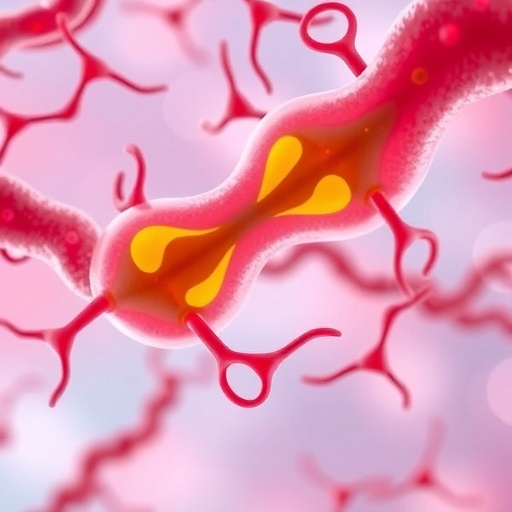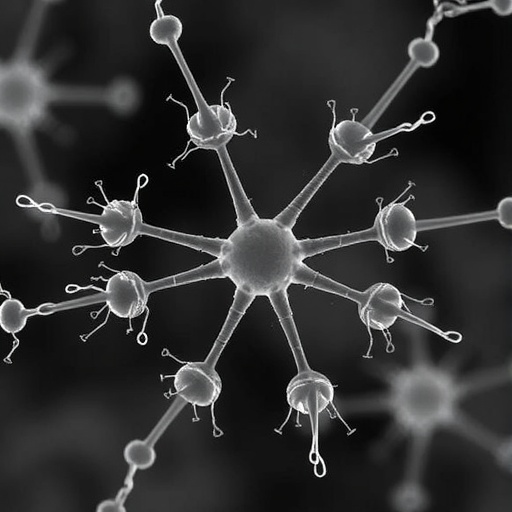In recent years, the intricate biochemical pathways governing lipid metabolism and their impact on cellular health have captured the attention of researchers worldwide. Among these pathways, the metabolism of sphingolipids—a class of essential lipids involved in cellular signaling and structural integrity—stands out for its complexity and relevance to various diseases. A groundbreaking study published in Nature Communications now uncovers a critical link between very long-chain fatty acids and the toxicity induced by 1-deoxy-sphingolipids, offering new insights into the molecular underpinnings of lipid-mediated cellular dysfunction.
Sphingolipids are vital components of cell membranes and play crucial roles in mediating signal transduction, cell-cell interactions, and apoptosis. One of the rare types of sphingolipids, 1-deoxy-sphingolipids, deviates from the canonical sphingolipid synthesis pathway due to the lack of a hydroxyl group at the first carbon position. This structural anomaly confers unusual biophysical properties and toxic potential. Accumulation of 1-deoxy-sphingolipids has been implicated in disorders such as hereditary sensory and autonomic neuropathies (HSAN) and metabolic syndromes, but the exact molecular mechanisms mediating their toxicity remained elusive—until now.
The research team led by Majcher and colleagues delved deeply into the interplay between 1-deoxy-sphingolipids and very long-chain fatty acids (VLCFAs), which are fatty acids with more than 22 carbon atoms in their acyl chains. VLCFAs themselves are biologically significant, contributing to membrane structure and function, as well as serving as precursors for specialized lipid molecules. By combining advanced lipidomic analyses, molecular biology techniques, and in vitro toxicology assays, the investigators demonstrated that VLCFAs substantially exacerbate the cytotoxic effects of 1-deoxy-sphingolipids.
One of the key revelations of this study is the biochemical synergy between VLCFAs and 1-deoxy-sphingolipids. The authors discovered that when 1-deoxy-sphingolipids are conjugated with VLCFAs, their hydrophobicity and capacity to integrate into cellular membranes increase dramatically. This conjugation disrupts membrane homeostasis and impairs critical membrane-bound processes such as ion transport and receptor signaling, culminating in cellular stress responses. The synergistic effect leads to a heightened state of lipotoxicity that is more severe than the effects of either molecule alone.
Moreover, the researchers utilized state-of-the-art mass spectrometry imaging to map the subcellular localization of VLCFA-conjugated 1-deoxy-sphingolipids. They found a preferential accumulation in mitochondrial and endoplasmic reticulum membranes, organelles essential for energy metabolism and protein folding, respectively. The perturbation of these membranes triggers mitochondrial dysfunction and endoplasmic reticulum stress, both of which are hallmarks of degenerative diseases and metabolic imbalances.
To understand the implications of these findings, it is important to consider the enzymatic pathways responsible for the synthesis and elongation of VLCFAs. Elongases, a family of enzymes embedded in the endoplasmic reticulum membrane, facilitate the addition of two-carbon units to acyl-CoA substrates, ultimately generating VLCFAs. Mutations or dysregulation of elongase activity can alter VLCFA profiles within the cell. The study provides evidence that such dysregulation could lead to increased incorporation of VLCFAs into toxic 1-deoxy-sphingolipids, amplifying their harmful effects.
The cellular consequences of this lipid alteration extend beyond membrane integrity. According to the study, the VLCFA-driven toxicity of 1-deoxy-sphingolipids results in dysregulation of calcium homeostasis, an essential factor in neuronal signaling and survival. Altered calcium dynamics can precipitate excitotoxicity and programmed cell death, which aligns with clinical observations of neuropathic degeneration associated with 1-deoxy-sphingolipid accumulation.
Furthermore, the investigation sheds light on potential therapeutic strategies targeting this pathological lipid interaction. By modulating elongase activity or inhibiting the synthesis of VLCFA-conjugated 1-deoxy-sphingolipids, it may be possible to mitigate their toxic effects. The authors propose the development of small-molecule inhibitors and lipid metabolic modulators as promising candidates for intervention in lipid-related neurodegenerative conditions.
Importantly, the study also explores the broader physiological and pathological relevance of VLCFA-mediated 1-deoxy-sphingolipid toxicity. Given that VLCFAs are abundant in neural tissues, where membrane specialization is critical, disruptions in their metabolism could underlie a variety of neurodegenerative disorders. These insights may prompt a reevaluation of the lipidomic landscape in conditions such as multiple sclerosis, Parkinson’s disease, and metabolic neuropathies.
From a methodological perspective, the research exemplifies the power of multidisciplinary approaches. Integrating lipidomics with high-resolution imaging, genetic manipulation, and biochemical assays allowed for a nuanced dissection of these complex molecular interactions. This holistic view paves the way for future studies aiming to comprehensively understand lipid-driven cellular pathology.
The clinical implications of this work cannot be overstated. By delineating the molecular nexus between VLCFAs and 1-deoxy-sphingolipids, the research opens new diagnostic avenues. Biomarkers based on the quantification of VLCFA-conjugated sphingolipids could offer early detection of lipid metabolism disorders and enable personalized medicine approaches for affected individuals.
On the cellular level, the disruption of organelle function due to aberrant lipid incorporation represents a fundamental challenge to cell survival. The study’s findings underscore the importance of maintaining lipid homeostasis, not only in lipid-rich neural environments but across multiple tissue types where membrane composition dictates cellular function.
This work also highlights the double-edged nature of lipids in biology; while essential for life, their dysregulation can precipitate pathological cascades. Understanding how specific lipid species interact and affect cellular physiology offers a refined perspective that could influence drug development strategies targeting metabolic diseases, cancer, and neurodegeneration.
In an era where metabolic diseases are rapidly increasing worldwide, the insights provided by Majcher and colleagues have wide-reaching importance. By unraveling the hidden toxic synergy between VLCFAs and 1-deoxy-sphingolipids, the study enhances our understanding of molecular pathology and sets a precedent for future lipid research.
Beyond the immediate clinical and biomedical relevance, this research raises intriguing questions regarding lipid evolution and cellular adaptation mechanisms. The specificity of VLCFA interaction with modified sphingolipids suggests evolutionary pressure to fine-tune lipid composition for optimal function while minimizing toxicity.
In conclusion, the discovery that very long-chain fatty acids drive the toxicity of 1-deoxy-sphingolipids constitutes a significant advancement in lipid biology and disease understanding. It opens a new frontier for therapeutic innovation and enriches our comprehension of the intricate interplay between lipid metabolism and cellular health. Future research inspired by these findings promises to unravel even deeper layers of complexity surrounding lipotoxicity and its role in human disease.
Subject of Research: The biochemical interaction between very long-chain fatty acids and 1-deoxy-sphingolipids and their contribution to lipid-induced cellular toxicity.
Article Title: Very long-chain fatty acids drive 1-deoxySphingolipid toxicity.
Article References:
Majcher, A., Karsai, G., Yusifov, E. et al. Very long-chain fatty acids drive 1-deoxySphingolipid toxicity.
Nat Commun (2025). https://doi.org/10.1038/s41467-025-66687-8
Image Credits: AI Generated
Tags: 1-deoxy-sphingolipid toxicitybiochemical pathways of lipid metabolismcellular signaling and lipid healthhereditary sensory and autonomic neuropathiesinsights into lipid toxicity mechanismslipid-mediated cellular dysfunctionmetabolic syndrome and sphingolipidsrole of sphingolipids in cell membranessphingolipid metabolismstructural properties of sphingolipidstoxic potential of 1-deoxy-sphingolipidsvery long-chain fatty acids





